Yao Su
A Survey on Post-training of Large Language Models
Mar 08, 2025Abstract:The emergence of Large Language Models (LLMs) has fundamentally transformed natural language processing, making them indispensable across domains ranging from conversational systems to scientific exploration. However, their pre-trained architectures often reveal limitations in specialized contexts, including restricted reasoning capacities, ethical uncertainties, and suboptimal domain-specific performance. These challenges necessitate advanced post-training language models (PoLMs) to address these shortcomings, such as OpenAI-o1/o3 and DeepSeek-R1 (collectively known as Large Reasoning Models, or LRMs). This paper presents the first comprehensive survey of PoLMs, systematically tracing their evolution across five core paradigms: Fine-tuning, which enhances task-specific accuracy; Alignment, which ensures alignment with human preferences; Reasoning, which advances multi-step inference despite challenges in reward design; Efficiency, which optimizes resource utilization amidst increasing complexity; and Integration and Adaptation, which extend capabilities across diverse modalities while addressing coherence issues. Charting progress from ChatGPT's foundational alignment strategies to DeepSeek-R1's innovative reasoning advancements, we illustrate how PoLMs leverage datasets to mitigate biases, deepen reasoning capabilities, and enhance domain adaptability. Our contributions include a pioneering synthesis of PoLM evolution, a structured taxonomy categorizing techniques and datasets, and a strategic agenda emphasizing the role of LRMs in improving reasoning proficiency and domain flexibility. As the first survey of its scope, this work consolidates recent PoLM advancements and establishes a rigorous intellectual framework for future research, fostering the development of LLMs that excel in precision, ethical robustness, and versatility across scientific and societal applications.
End-to-End Deep Learning for Structural Brain Imaging: A Unified Framework
Feb 23, 2025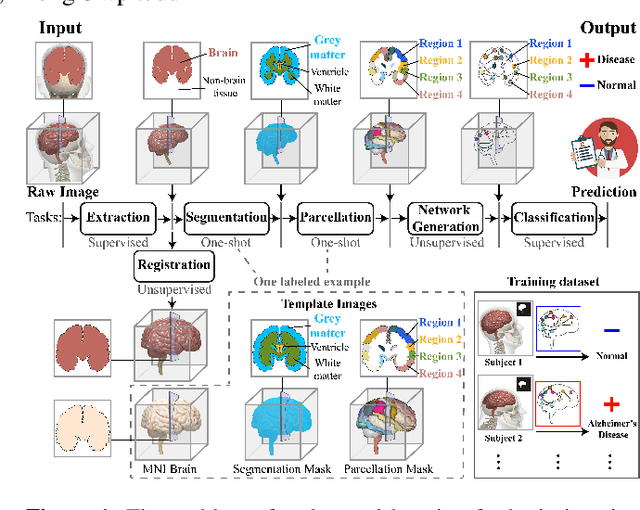

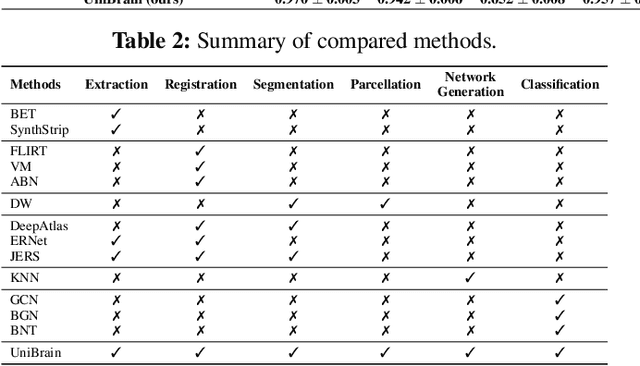

Abstract:Brain imaging analysis is fundamental in neuroscience, providing valuable insights into brain structure and function. Traditional workflows follow a sequential pipeline-brain extraction, registration, segmentation, parcellation, network generation, and classification-treating each step as an independent task. These methods rely heavily on task-specific training data and expert intervention to correct intermediate errors, making them particularly burdensome for high-dimensional neuroimaging data, where annotations and quality control are costly and time-consuming. We introduce UniBrain, a unified end-to-end framework that integrates all processing steps into a single optimization process, allowing tasks to interact and refine each other. Unlike traditional approaches that require extensive task-specific annotations, UniBrain operates with minimal supervision, leveraging only low-cost labels (i.e., classification and extraction) and a single labeled atlas. By jointly optimizing extraction, registration, segmentation, parcellation, network generation, and classification, UniBrain enhances both accuracy and computational efficiency while significantly reducing annotation effort. Experimental results demonstrate its superiority over existing methods across multiple tasks, offering a more scalable and reliable solution for neuroimaging analysis. Our code and data can be found at https://github.com/Anonymous7852/UniBrain
Beyond Single-Value Metrics: Evaluating and Enhancing LLM Unlearning with Cognitive Diagnosis
Feb 19, 2025Abstract:Due to the widespread use of LLMs and the rising critical ethical and safety concerns, LLM unlearning methods have been developed to remove harmful knowledge and undesirable capabilities. In this context, evaluations are mostly based on single-value metrics such as QA accuracy. However, these metrics often fail to capture the nuanced retention of harmful knowledge components, making it difficult to assess the true effectiveness of unlearning. To address this issue, we propose UNCD (UNlearning evaluation via Cognitive Diagnosis), a novel framework that leverages Cognitive Diagnosis Modeling for fine-grained evaluation of LLM unlearning. Our dedicated benchmark, UNCD-Cyber, provides a detailed assessment of the removal of dangerous capabilities. Moreover, we introduce UNCD-Agent, which refines unlearning by diagnosing knowledge remnants and generating targeted unlearning data. Extensive experiments across eight unlearning methods and two base models demonstrate that UNCD not only enhances evaluation but also effectively facilitates the removal of harmful LLM abilities.
Rethinking Functional Brain Connectome Analysis: Do Graph Deep Learning Models Help?
Jan 28, 2025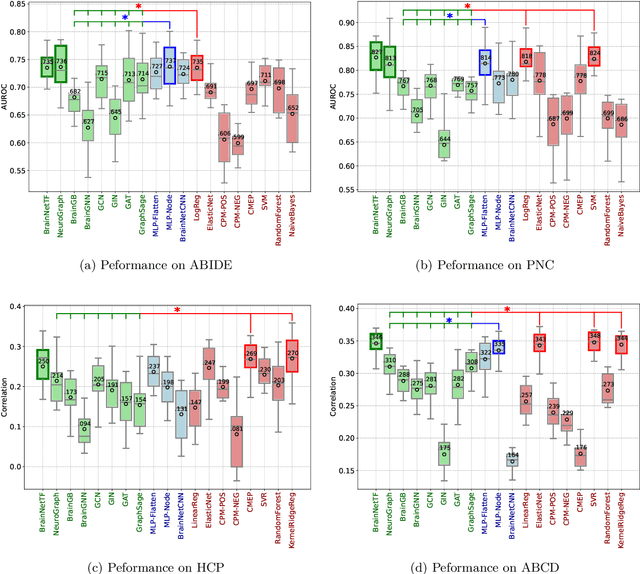
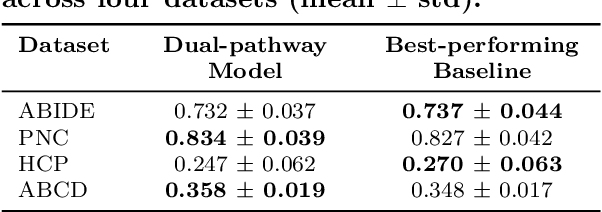
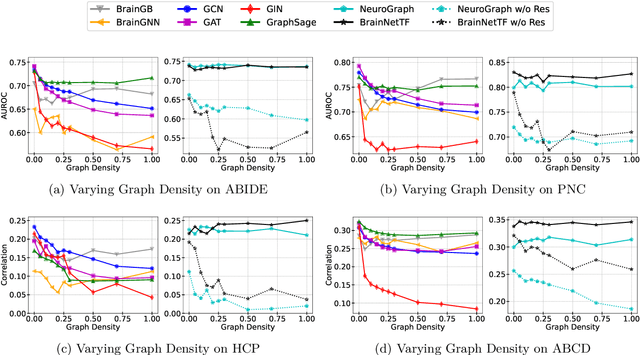
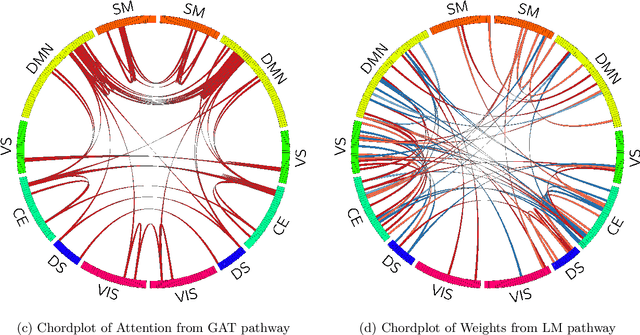
Abstract:Functional brain connectome is crucial for deciphering the neural mechanisms underlying cognitive functions and neurological disorders. Graph deep learning models have recently gained tremendous popularity in this field. However, their actual effectiveness in modeling the brain connectome remains unclear. In this study, we re-examine graph deep learning models based on four large-scale neuroimaging studies encompassing diverse cognitive and clinical outcomes. Surprisingly, we find that the message aggregation mechanism, a hallmark of graph deep learning models, does not help with predictive performance as typically assumed, but rather consistently degrades it. To address this issue, we propose a hybrid model combining a linear model with a graph attention network through dual pathways, achieving robust predictions and enhanced interpretability by revealing both localized and global neural connectivity patterns. Our findings urge caution in adopting complex deep learning models for functional brain connectome analysis, emphasizing the need for rigorous experimental designs to establish tangible performance gains and perhaps more importantly, to pursue improvements in model interpretability.
PR2: A Physics- and Photo-realistic Testbed for Embodied AI and Humanoid Robots
Sep 03, 2024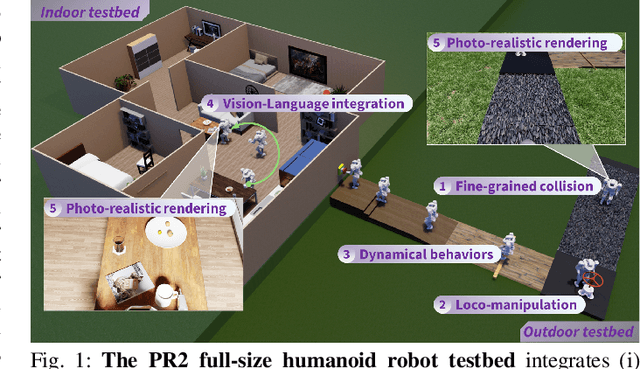

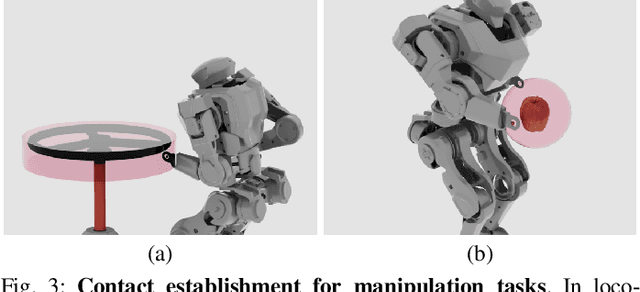

Abstract:This paper presents the development of a Physics-realistic and Photo-\underline{r}ealistic humanoid robot testbed, PR2, to facilitate collaborative research between Embodied Artificial Intelligence (Embodied AI) and robotics. PR2 offers high-quality scene rendering and robot dynamic simulation, enabling (i) the creation of diverse scenes using various digital assets, (ii) the integration of advanced perception or foundation models, and (iii) the implementation of planning and control algorithms for dynamic humanoid robot behaviors based on environmental feedback. The beta version of PR2 has been deployed for the simulation track of a nationwide full-size humanoid robot competition for college students, attracting 137 teams and over 400 participants within four months. This competition covered traditional tasks in bipedal walking, as well as novel challenges in loco-manipulation and language-instruction-based object search, marking a first for public college robotics competitions. A retrospective analysis of the competition suggests that future events should emphasize the integration of locomotion with manipulation and perception. By making the PR2 testbed publicly available at https://github.com/pr2-humanoid/PR2-Platform, we aim to further advance education and training in humanoid robotics.
Large-scale Deployment of Vision-based Tactile Sensors on Multi-fingered Grippers
Aug 05, 2024Abstract:Vision-based Tactile Sensors (VBTSs) show significant promise in that they can leverage image measurements to provide high-spatial-resolution human-like performance. However, current VBTS designs, typically confined to the fingertips of robotic grippers, prove somewhat inadequate, as many grasping and manipulation tasks require multiple contact points with the object. With an end goal of enabling large-scale, multi-surface tactile sensing via VBTSs, our research (i) develops a synchronized image acquisition system with minimal latency,(ii) proposes a modularized VBTS design for easy integration into finger phalanges, and (iii) devises a zero-shot calibration approach to improve data efficiency in the simultaneous calibration of multiple VBTSs. In validating the system within a miniature 3-fingered robotic gripper equipped with 7 VBTSs we demonstrate improved tactile perception performance by covering the contact surfaces of both gripper fingers and palm. Additionally, we show that our VBTS design can be seamlessly integrated into various end-effector morphologies significantly reducing the data requirements for calibration.
Flight Structure Optimization of Modular Reconfigurable UAVs
Jul 04, 2024



Abstract:This paper presents a Genetic Algorithm (GA) designed to reconfigure a large group of modular Unmanned Aerial Vehicles (UAVs), each with different weights and inertia parameters, into an over-actuated flight structure with improved dynamic properties. Previous research efforts either utilized expert knowledge to design flight structures for a specific task or relied on enumeration-based algorithms that required extensive computation to find an optimal one. However, both approaches encounter challenges in accommodating the heterogeneity among modules. Our GA addresses these challenges by incorporating the complexities of over-actuation and dynamic properties into its formulation. Additionally, we employ a tree representation and a vector representation to describe flight structures, facilitating efficient crossover operations and fitness evaluations within the GA framework, respectively. Using cubic modular quadcopters capable of functioning as omni-directional thrust generators, we validate that the proposed approach can (i) adeptly identify suboptimal configurations ensuring over-actuation while ensuring trajectory tracking accuracy and (ii) significantly reduce computational costs compared to traditional enumeration-based methods.
Dynamic Planning for Sequential Whole-body Mobile Manipulation
May 24, 2024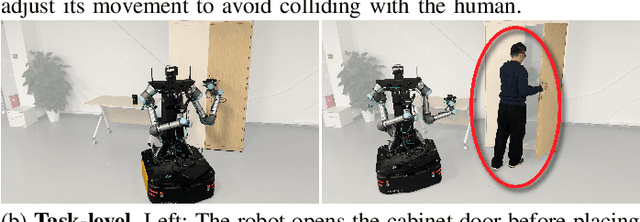
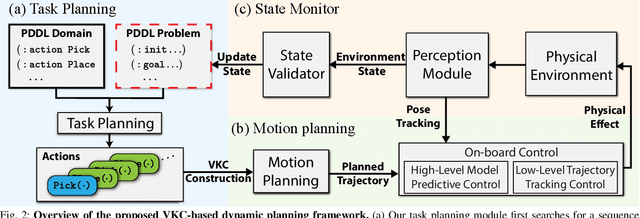
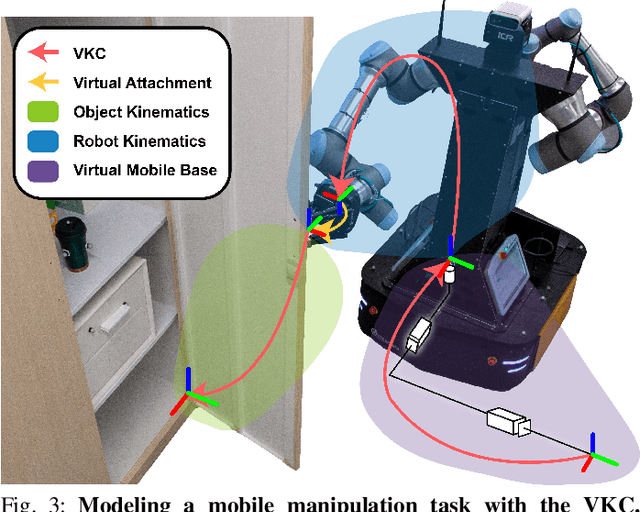
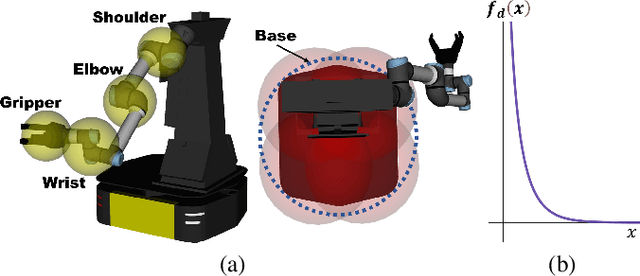
Abstract:The dynamic Sequential Mobile Manipulation Planning (SMMP) framework is essential for the safe and robust operation of mobile manipulators in dynamic environments. Previous research has primarily focused on either motion-level or task-level dynamic planning, with limitations in handling state changes that have long-term effects or in generating responsive motions for diverse tasks, respectively. This paper presents a holistic dynamic planning framework that extends the Virtual Kinematic Chain (VKC)-based SMMP method, automating dynamic long-term task planning and reactive whole-body motion generation for SMMP problems. The framework consists of an online task planning module designed to respond to environment changes with long-term effects, a VKC-based whole-body motion planning module for manipulating both rigid and articulated objects, alongside a reactive Model Predictive Control (MPC) module for obstacle avoidance during execution. Simulations and real-world experiments validate the framework, demonstrating its efficacy and validity across sequential mobile manipulation tasks, even in scenarios involving human interference.
CDM-MPC: An Integrated Dynamic Planning and Control Framework for Bipedal Robots Jumping
May 20, 2024



Abstract:Performing acrobatic maneuvers like dynamic jumping in bipedal robots presents significant challenges in terms of actuation, motion planning, and control. Traditional approaches to these tasks often simplify dynamics to enhance computational efficiency, potentially overlooking critical factors such as the control of centroidal angular momentum (CAM) and the variability of centroidal composite rigid body inertia (CCRBI). This paper introduces a novel integrated dynamic planning and control framework, termed centroidal dynamics model-based model predictive control (CDM-MPC), designed for robust jumping control that fully considers centroidal momentum and non-constant CCRBI. The framework comprises an optimization-based kinodynamic motion planner and an MPC controller for real-time trajectory tracking and replanning. Additionally, a centroidal momentum-based inverse kinematics (IK) solver and a landing heuristic controller are developed to ensure stability during high-impact landings. The efficacy of the CDM-MPC framework is validated through extensive testing on the full-sized humanoid robot KUAVO in both simulations and experiments.
ASPIRe: An Informative Trajectory Planner with Mutual Information Approximation for Target Search and Tracking
Mar 04, 2024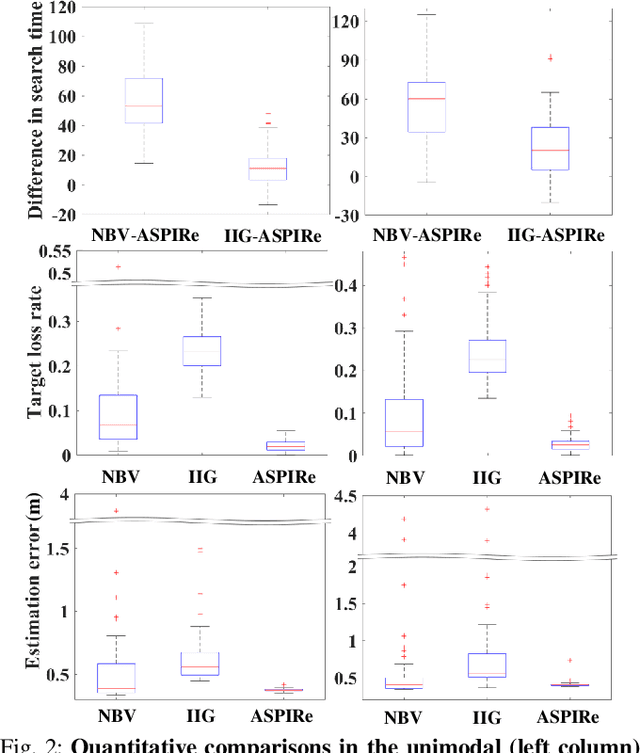
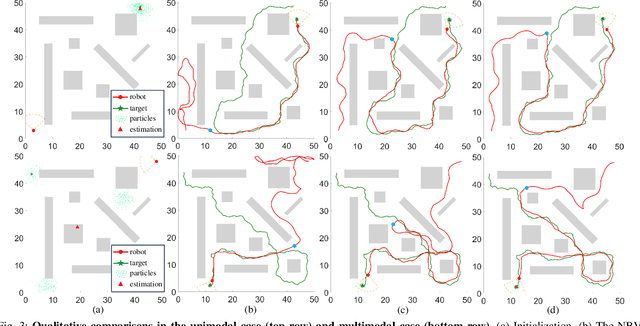
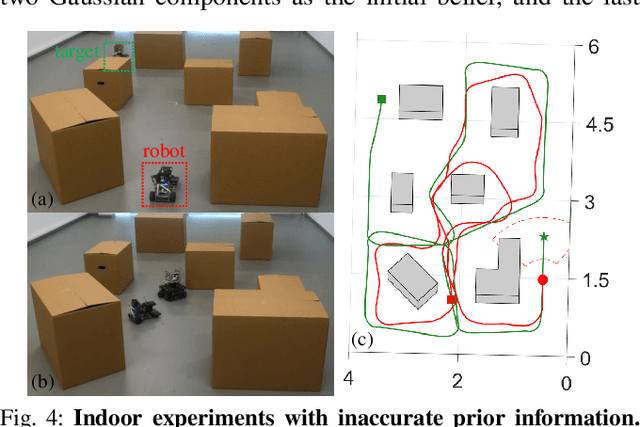
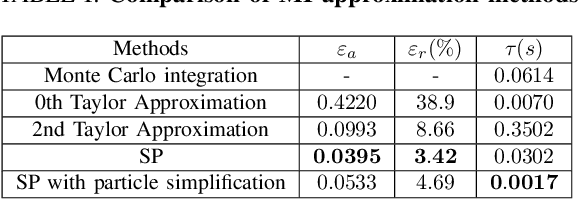
Abstract:This paper proposes an informative trajectory planning approach, namely, \textit{adaptive particle filter tree with sigma point-based mutual information reward approximation} (ASPIRe), for mobile target search and tracking (SAT) in cluttered environments with limited sensing field of view. We develop a novel sigma point-based approximation to accurately estimate mutual information (MI) for general, non-Gaussian distributions utilizing particle representation of the belief state, while simultaneously maintaining high computational efficiency. Building upon the MI approximation, we develop the Adaptive Particle Filter Tree (APFT) approach with MI as the reward, which features belief state tree nodes for informative trajectory planning in continuous state and measurement spaces. An adaptive criterion is proposed in APFT to adjust the planning horizon based on the expected information gain. Simulations and physical experiments demonstrate that ASPIRe achieves real-time computation and outperforms benchmark methods in terms of both search efficiency and estimation accuracy.
 Add to Chrome
Add to Chrome Add to Firefox
Add to Firefox Add to Edge
Add to Edge